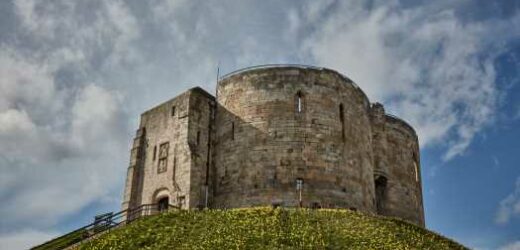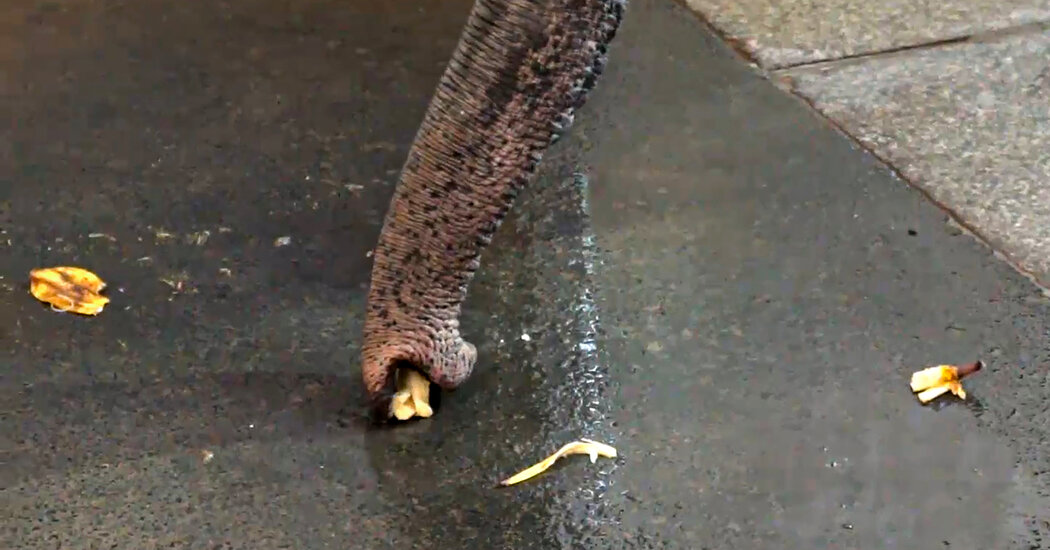One bright morning, as I was scouring Aldwark, a slender lane in York, England, searching for a certain historical site, a delivery truck pulled up. The driver, a man who looked to be in his 60s, got out and asked if he could help.
I hesitated for a beat. As it is throughout the West, antisemitism is on the rise in Britain: According to the London-based Community Security Trust, Britain has experienced a more than 400 percent increase in antisemitic incidents since 2013. Nonetheless, I replied: “I heard there used to be synagogue back here. Until the 1970s.”
I wasn’t sure what to expect — a bemused shrug, or maybe what one English acquaintance calls “the sneer,” a look that conveys the sentiment, held by some in Britain, that Jews aren’t really English. What I got, though, was a solemn gaze.
“I’m surprised to hear that,” he said, “given the history of the place.”
I knew what he meant.
In March 1190, the Jews of York got word that a mob was coming to murder them and loot their homes. They took refuge in York Castle’s keep, but the mob surrounded it and demanded the Jews surrender and submit to baptism, or die. Most chose death. Those who agreed to be baptized were slaughtered anyway upon leaving. York’s entire Jewish community, some 150 souls, was wiped out in a single day.
You might, like that truck driver, expect Jews would never return there. But they did — quickly. And they prospered.
“In the first 30, 40 years of the 13th century, the community is, if anything, wealthier and stronger than it was up to 1190,” John Oxley, York’s city archaeologist, told me.
The Jews of medieval York lived where they pleased — there was no ghetto, or even an informal Jewish quarter, known as a Jewry. They built their synagogue on Coney Street, then as now the heart of the city. In many ways, what unfolded in York eight centuries ago encapsulates the saga of all medieval England’s Jews, thousands of them spread out among dozens of communities. They suffered unimaginably, but also thrived fantastically; were inextricable from the fortunes of the country, yet are mostly forgotten today. Their story was dramatic, and sweeping — and ended all at once.
You can still find remnants of it.
But it’ll take some doing.
The ‘king’s men’
It’s strange to think that any facet of its past — much less one that runs so deep — could remain obscure in a history-mad place like Britain. Yet when I visited her a few months before the pandemic, Sally Dixon-Smith, then the curator of collections at the Tower of London, told me, “Most English people of whatever religion don’t know there was a medieval Jewish community here.” Even the tower — which played an important role in the lives of London’s medieval Jews, and which is packed with historic markers and kiosks — had almost nothing on display addressing the subject. “We’re trying to do something about it,” Dr. Dixon-Smith explained, “but like any Heritage site, this isn’t going to be fast.”
The story of England’s medieval Jewish communities, she said, has “never been thought ‘important’ enough by mainstream academia, if you like, to be included as part of that narrative.” This galls her: “You cannot talk about the medieval English economy without talking about the Jewish community,” she said. “It’s ludicrous to have them excluded from this history.”
Jews most likely started visiting Britain in ancient times, but it wasn’t until William the Conqueror enticed some to come over from Normandy after his victory at Hastings in 1066 that Jewish communities took root on English soil. William needed capital to subdue the country and build its economy; Jews had it. To encourage them, William offered special protections. They would be the “king’s men,” answerable only to the sovereign. Harming them would be an offense against the crown. They could, if need be, take shelter in any royal castle, including the Tower of London.
Their first English century was fairly harmonious. “Initially, the relationship between the Jews and the Christians was pretty good,” John Rayne-Davis, a historian in Yorkshire, told me. “They used to drink in one another’s houses and fraternize and such.”
Medieval England’s Jews didn’t just work in finance. “Some would be selling wine, food, cheese,” Marcus Roberts, the director of J-Trails, an Anglo-Jewish heritage organization, explained. “There was one Jew who was a ladder maker. There was one Jew in Essex who had a very successful business selling firewood. But there were also Jewish men-at-arms.” Jewish scholarship flourished in medieval England, sometimes in cooperation with Christian theologians. Jews and Christians lived side by side. Some intermarried.
But as the decades passed, Jews’ special status and relative prosperity — and the fact that a lot of people owed them money — bred resentment. An increasingly antisemitic Vatican, and a concurrent rise in Christian religious fervor, only raised tensions. There were more pogroms. At the same time, successive monarchs rolled back Jews’ rights and protections and wrung ever more money out of them — not just through loans but also special taxes, extortion and appropriation — to fund their own lavish lifestyles and undertake pet projects, like waging wars and building castles, churches and other landmarks like Westminster Abbey.
But no plaque on the abbey, Dr. Dixon-Smith lamented, detailed its Jewish roots. Nor was there anything at the Tower of London attesting to the fact that most of it was built with Jewish capital, as Dr. Dixon-Smith and other historians have noted. London’s medieval Jewish community was, by far, England’s largest and most affluent, but today, just about the only visible indication that it even existed is a very early street named Old Jewry — a testament to what was there nine centuries ago.
That’s not to say that nothing more substantial remains of medieval England’s Jewish communities. But you need to get out of London to see it.
Spires and synagogues
Clifford’s Tower, at the site of York’s 1190 pogrom, is probably the best-known medieval Jewish destination in England. If you’re in search of something less tragic, though, there are a few other places to visit.
In Norwich, for instance, there’s a 12th-century dwelling that belonged to a Jewish man named Jurnet, said to be one of the richest people in England at that time; today, it’s part of an adult-education complex. In Bury St. Edmund’s, another 12th-century edifice known as Moyse’s Hall — “Moyse” is believed to be a version of “Moses” — houses a wonderful local museum where, among other things, I saw my first mummified cats.
The Northampton Museum and Art Gallery even has a 13th-century Jewish grave marker. Etched into a mottled brownish chunk of limestone, its Hebrew letters are remarkably crisp. Though much of the inscription is missing, Mr. Roberts of J-Trails believes it originally read: “This is the tombstone of the learned scholar Shlomo ben Rav Moshe.” Quite possibly the oldest extant tombstone in the country, it was discovered in the rubble of a 14th-century home that was demolished around 1842. It had been looted from Northampton’s medieval Jewish cemetery and used to build the house’s foundation.
And then there’s Lincoln. Lincoln is special.
Start with the city’s cathedral, once the tallest edifice in the world, which was, like others in medieval England, built with Jewish financing. Among the many figures in its soaring stained-glass windows, you’ll find — it’s kind of a “Where’s Waldo?” exercise — Jews in the distinctive pointed hats they were required to wear in medieval Europe.
The cathedral’s southern entrance is known as the Judgment Portal. Carved around eye level at its right (or “good”) side, an angel supports a perch, atop which stands a radiant statue representing Church. On its left side, though, another figure, representing Synagogue, stands, blindfolded and forlorn, atop a platform borne upon the back of a Jewish wretch. “You would never find it unless you knew it was there,” Richard Dale, chairman of the Lincolnshire Jewish Community, explained. “It’s like antisemitism — until you become aware of it, you’re not necessarily aware of it.”
Pilgrims historically passed through this door on their way to the tomb of the lad who, though never canonized, is still called Little St. Hugh: a young boy of Lincoln who, in 1255, was falsely said to have been kidnapped by Jews and ritually murdered. Though many Christians denounced the accusations, pious King Henry III had 18 Lincoln Jews hanged at the Tower of London — then seized their estates. A marker in Lincoln Cathedral that related the tale in a way many found offensive was not reworded until 2009.
If a blood libel leaves you cold, you’ll find some wondrous survivors along one of Lincoln’s main thoroughfares, Steep Hill. To start, there’s Jews House, which was named for a prior owner, said to be a woman called Belaset. Built around 1170, it’s believed to be one of the oldest domiciles in England; today it houses a restaurant and a beauty salon. While the restaurant’s owner wouldn’t allow me to look around, the salon’s proprietor was, thankfully, happy to. It’s not every day an American encounters a 12th-century building.
The building next door, a four-story stone edifice known as Jews Court, is where, 800 years ago, the Jews of Lincoln are believed to have had their synagogue. In 1992, when Mr. Dale went looking for a space in which the recently reconstituted Jewish community of Lincoln could hold services, he discovered the upstairs of Jews Court was available. Aside from some thick, dark, ancient wooden beams, it’s fairly unadorned — whitewashed surfaces, fluorescent lights, a honey-hued ark set into a wall. Still, he confessed, “it gives me a bit of a buzz every time I come here.”
Farther up Steep Hill is another building of similar vintage, the Norman House, that would rank, even today, as one of the finest dwellings in Lincoln. Like Jews House and Jews Court, it was built of stone, which helps explain both its longevity and its Hebraic association: A disproportionate number of the stone houses built back then — and there were very few, because of the astronomical expense — were commissioned by Jews, for security in an environment that was inherently insecure. Today it’s occupied by a tea importer, and its undercroft houses a coffee shop, where I enjoyed a cuppa beneath an 850-year-old arched ceiling.
For ages, the building was known as Aaron the Jew’s house: Aaron of Lincoln was said to have been the richest man in 12th-century England — to have had more money, even, than the king. A kiosk across the street, though, says it actually belonged to another Jew, a man named Joceus. The kiosk offers nothing more about him, but I knew the name: Once Aaron’s top agent in York, he was among the 150 Jews who perished in that city in March 1190.
Indignity and expulsion
It wasn’t pogroms that ultimately drove the Jews from medieval England; it was their “protector,” the crown. By the 13th century, England’s kings had largely stopped borrowing from Jews and started just taking their capital instead, often by executing them for crimes they hadn’t committed. At the same time, their freedoms — to live where they pleased, dress how they liked, work as it suited them, associate with whomever they wished — were curtailed further and further. By the centennial of the York massacre, “an awful lot of people had already left — or been killed,” Dr. Dixon-Smith said.
On July 18, 1290, King Edward I, having squeezed everything out of them, issued a decree expelling all Jews from England. They were given just a few months to settle their affairs, pack up and get out — with one final insult. “Even people who lived in ports were instructed to come to the tower to be deported from here,” Dr. Dixon-Smith explained. They lined up on its wharf, recently built by Edward with money he had extracted from them and, before embarking, were “charged a couple of pence each,” she explained, “for deportation.” No plaque commemorated any of this either, she noted.
When finally allowed to return, several centuries later, they endured no more pogroms, but still experienced plenty of ugliness: At London’s fine Jewish Museum, you can view medieval artifacts, but also grotesque 18th-century caricatures that would have looked at home in Julius Streicher’s Nazi newspaper Der Stürmer 200 years later — and sadly, on certain websites today. At heart, they echo that sneer: Jews aren’t really English.
It’s an archaic sensibility, though not as old as the Domesday Book, in which Jews are listed; or Magna Carta, in which Jews are mentioned — twice; or some of the country’s oldest standing houses, built by Jews; or many of the national treasures that wouldn’t exist without them.
Back on that bright morning in York, after my encounter with the truck driver on Aldwark, I wandered over to Coney Street to see where the city’s medieval synagogue had once stood. I knew the precise address: A clothing store sat there now, a historical marker adorning its facade. It did, indeed, pay tribute to an earlier edifice on the site, though not the one I was thinking of. “The George Inn,” it proclaimed. “The sisters Charlotte and Anne Brontë stayed here in 1849.”
Later that day, I stopped by Mr. Oxley’s office and told him about it. He shook his head.
“That is just so typically English,” he said with a sigh.
Follow New York Times Travel on Instagram and sign up for our weekly Travel Dispatch newsletter to get expert tips on traveling smarter and inspiration for your next vacation. Dreaming up a future getaway or just armchair traveling? Check out our 52 Places to Go in 2023.
Source: Read Full Article



